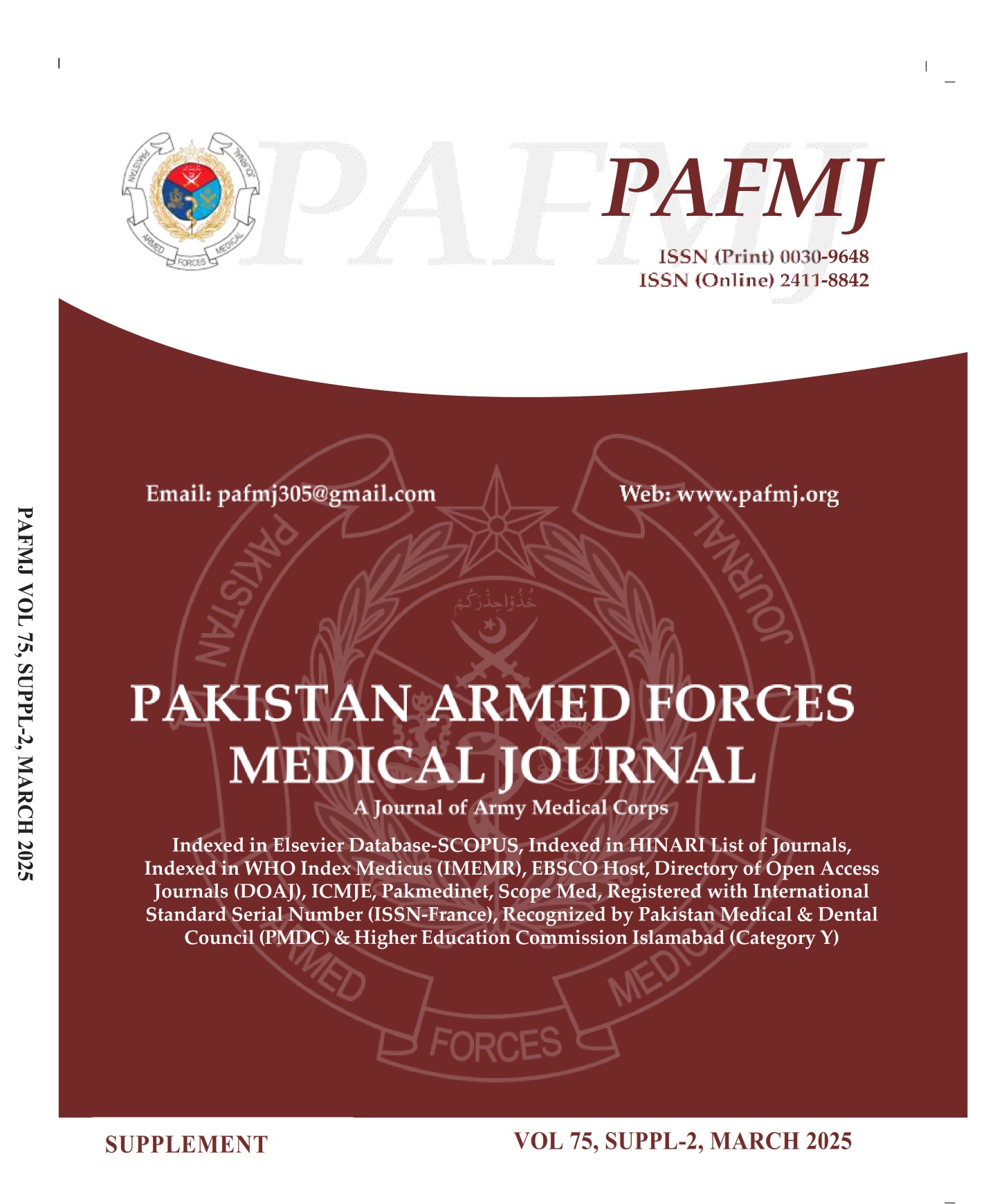Rise in Pseudomyopia in Time of Covid-19 Pandemic-A Possible Correlation with Screen Time
DOI:
https://doi.org/10.51253/pafmj.v75iSUPPL-2.8073Keywords:
Computer Vision Syndrome, Myopia, Pseudomyopia.Abstract
Objective: To evaluate the presence of pseudo myopia in different age groups and its association with screen time in patients who present with reduced vision during the covid-19 pandemic in Pakistan.
Study Design: Cross-sectional study.
Place and Duration of Study: Combined Military Hospital, Abbottabad Pakistan, from Nov 2020 to Apr 2021.
Methodology: A total of 222 eyes of 111 patients with reduced vision and myopia were evaluated. All patients underwent cycloplegic refraction, and re-evaluation of myopia. An increment in myopia of 0.50 D or more after cycloplegia with cyclopentolate was labeled “Pseudomyopia”. The incidence was evaluated in different age groups and its association with screen time and study time was evaluated.
Results: Mean age of study population was 21.16±8.45 years. Mean pre-cycloplegic myopia was -2.32±1.99D and mean post-cycloplegic myopia was -1.39±1.64D. Mean change in myopia after cycloplegia was -0.98±2.07D. Pseudo myopia was found in 120(54.1%) eyes. Difference in frequency of pseudomyopia between different age groups and difference in frequency of pseudomyopia between different groups with respect to screen time was statistically significant (p=<0.001) with more frequency in patients with more than 2 hours per day of screen time.
Conclusion: Pseudo myopia was more prevalent in younger patients and was correlated with increasing screen time in all age groups. Full cycloplegic refraction in all patients of myopia is warranted for accurate assessment of refractive error.
Downloads
References
Wong CW, Tsai A, Jonas JB, Ohno-Matsui K, Chen J, Ang M, et al. Digital Screen Time During the COVID-19 Pandemic: Risk for a Further Myopia Boom? Am J Ophthalmol Mar; 223: 333-337.
https://doi.org/10.1016/j.ajo.2020.07.034
Patil A, Bhavya, Chaudhury S, Srivastava S. Eyeing computer vision syndrome: Awareness, knowledge, and its impact on sleep quality among medical students. Ind Psychiatry J 2019; 28(1): 68-74.
Altalhi A, Khayyat W, Khojah O, Alsalmi M, Almarzouki H. Computer Vision Syndrome Among Health Sciences Students in Saudi Arabia: Prevalence and Risk Factors. Cureus. 2020; 12(2): e7060.
Mylona I, Deres ES, Dere GS, Tsinopoulos I, Glynatsis M. The Impact of Internet and Videogaming Addiction on Adolescent Vision: A Review of the Literature. Front Public Health 2020; 8: 63.
Rehan ST, Kumari U, Akhtar FK, Ullah I, Tahir MJ. Computer Vision Syndrome: An Unnoticed Prevailing Scourge to Radiologists. Acad Radiol 2022; 29(1): 173.
Sánchez-Brau M, Domenech-Amigot B, Brocal-Fernández F, Seguí-Crespo M. Computer vision syndrome in presbyopic digital device workers and progressive lens design. Ophthalmic Physiol Opt 2021; 41(4): 922-931.
Kolbe O, Degle S. Presbyopic Personal Computer Work: A Comparison of Progressive Addition Lenses for General Purpose and Personal Computer Work. Optom Vis Sci 2018; 95(11): 1046-1053.
Sánchez-Brau M, Domenech-Amigot B, Brocal-Fernández F, Quesada-Rico JA, Seguí-Crespo M. Prevalence of Computer Vision Syndrome and Its Relationship with Ergonomic and Individual Factors in Presbyopic VDT Workers Using Progressive Addition Lenses. Int J Environ Res Public Health 2020; 17(3): 1003.
Mimouni M, Zoller L, Horowitz J, Wygnanski-Jaffe T, Morad Y, Mezer E. Cycloplegic autorefraction in young adults: is it mandatory? Graefes Arch Clin Exp Ophthalmol 2016; 254(2): 395-398.
Sankaridurg P, He X, Naduvilath T, Lv M, Ho A, Smith E 3rd, et al. Comparison of noncycloplegic and cycloplegic autorefraction in categorizing refractive error data in children. Acta Ophthalmol 2017; 95(7): e633-e640.
https://doi.org/10.1111/aos.13569.
Wang J, Li Y, Musch DC, Wei N, Qi X, Ding G, et al. Progression of Myopia in School-Aged Children After COVID-19 Home Confinement. JAMA Ophthalmol 2021; 139(3): 293-300.
Cheng HC, Chang K, Shen E, Luo KS, Ying YH. Risk factors and behaviours of schoolchildren with myopia in Taiwan. International journal of environmental research and public health 2020; 17(6): 1967.
Chang LC, Liao LL, Chen ML, Niu YZ, Hsieh PL. Strengthening teachers’ abilities to implement a vision health program in Taiwanese schools. Health education research 2017; 32(5): 437-447.
Amusan OO, Musa KO, Aribaba OT, Aina AS, Onakoya AO, Akinsola FB. Comparison of autorefractor with focometer in patients with refractive errors attending Lagos University Teaching Hospital, Lagos, Nigeria-A cross sectional survey. Journal of Clinical Sciences 2021; 18(1): 24.
Fortenbaugh FC, Gustafson JA, Fonda JR, Fortier CB, Milberg WP, McGlinchey RE. Blast mild traumatic brain injury is associated with increased myopia and chronic convergence insufficiency. Vision Research 2021; 186: 1-2.
Kang MT, Jan C, Li S, Yusufu M, Liang X, Cao K, et al. Prevalence and risk factors of pseudomyopia in a Chinese children population: the Anyang Childhood Eye Study. Br J Ophthalmol 2021; 105(9): 1216-1221.
Chen X, Wang X, Naidu RK, Qian Y, Miao H, Zhou X. Effect of brimonidine tartrate 0.2% ophthalmic solution on visual quality after implantable collamer lens implantation with a central hole. International Ophthalmology 2021; 41(1): 293-301.
Dall’Orto GC, Facchin A, Bellatorre A, Maffioletti S, Serio M. Measurement of visual acuity with a digital eye chart: optotypes, presentation modalities and repeatability. Journal of Optometry 2021; 14(2): 133-141.
Liu S, Ye S, Xi W, Zhang X. Electronic devices and myopic refraction among children aged 6-14 years in urban areas of Tianjin, China. Ophthalmic Physiol Opt 2019; 39(4): 282-293.
Downloads
Published
Issue
Section
License
Copyright (c) 2025 Maeirah Shafique, Mohammad Asim Mehboob, Samar Fatima, Nauroz Fatima, Sobia U Shah, Beenish Saleem

This work is licensed under a Creative Commons Attribution-NonCommercial 4.0 International License.















